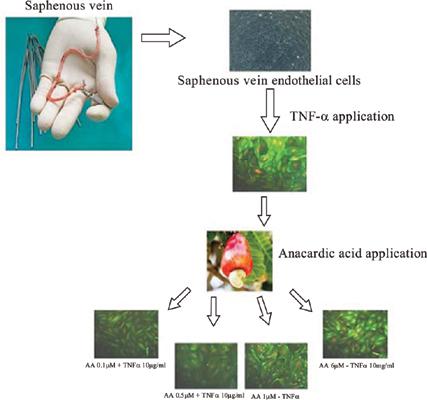Current Pharmaceutical Biotechnology ( IF 2.2 ) Pub Date : 2020-06-30 , DOI: 10.2174/1389201020666191105154619 Burak Önal 1 , Deniz Özen 2 , Bülent Demir 3 , Duygu Gezen Ak 4 , Erdinç Dursun 4 , Caner Demir 5 , Ahmet Gökhan Akkan 2 , Sibel Özyazgan 2

|
Background and Objective: Coronary bypass operations are commonly performed for the treatment of ischemic heart diseases. Coronary artery bypass surgery with autologous human saphenous vein maintains its importance as a commonly used therapy for advanced atherosclerosis. Vascular inflammation-related intimal hyperplasia and atherosclerotic progress have major roles in the pathogenesis of saphenous vein graft disease.
Methods: In our study, we investigated the effect of anacardic acid (AA), which is a bioactive phytochemical in the shell of Anacardium occidentale, on atherosclerosis considering its inhibitory effect on NF-κB. We observed relative ICAM-1 and NF-κB mRNA levels by qRT-PCR method in a TNF-α- induced inflammation model of saphenous vein endothelial cell culture after 0.1, 0.5, 1 and 5 μM of AA were applied to the cells. In addition, protein levels of ICAM-1 and NF-κB were evaluated by immunofluorescent staining. The results were compared between different concentrations of AA, and also with the control group.
Results: It was found that 5 μM, 1 μM and 0.5 μM of AA had toxic effects, while cytotoxicity decreased when 0.1 μM of AA was applied both alone and with TNF-α. When AA was applied with TNF-α, there was a decrease and suppression in NF-κB expression compared with the TNF-α group. TNF-α-induced ICAM-1 expression was significantly reduced more in the AA-applied group than in the TNF-α group.
Conclusion: In accordance with our results, it can be said that AA has a protective role in the pathogenesis of atherosclerosis and hence in saphenous vein graft disease.
中文翻译:

熊果酸对TNF-α诱导的人大隐静脉内皮细胞培养模型的抗炎作用。
背景与目的:冠状动脉搭桥手术通常用于治疗缺血性心脏病。自体大隐静脉的冠状动脉搭桥手术作为晚期动脉粥样硬化的常用疗法保持了其重要性。血管炎症相关的内膜增生和动脉粥样硬化进展在隐静脉移植疾病的发病机理中起着重要作用。
方法:在我们的研究中,我们考虑到对拟南芥(Anacardium occidentale)壳中的一种生物活性植物化学物质唐卡酸(AA)对动脉粥样硬化的影响,考虑到其对NF-κB的抑制作用。在将0.1、0.5、1和5μM的AA应用于细胞后,在TNF-α诱导的大隐静脉内皮细胞培养的炎症模型中,我们通过qRT-PCR方法观察了相对的ICAM-1和NF-κBmRNA水平。另外,通过免疫荧光染色评估了ICAM-1和NF-κB的蛋白水平。比较了不同浓度的AA和对照组的结果。
结果:发现5μM,1μM和0.5μM的AA具有毒性作用,而单独和与TNF-α一起使用0.1μM的AA则细胞毒性降低。当AA与TNF-α一起使用时,与TNF-α组相比,NF-κB表达降低和抑制。在AA施用组中,TNF-α诱导的ICAM-1表达明显比TNF-α组降低更多。
结论:根据我们的结果,可以说AA在动脉粥样硬化的发病机理中具有保护作用,因此在大隐静脉移植疾病中具有保护作用。











































 京公网安备 11010802027423号
京公网安备 11010802027423号